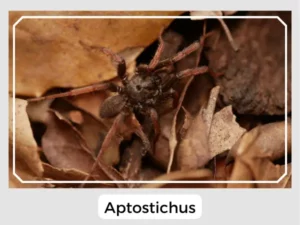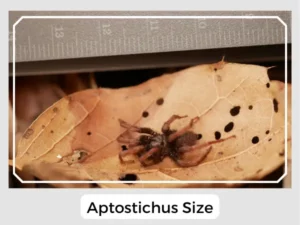The Aptostichus is a unique group of spiders in the Euctenizidae family. Guess what? As of May 2019, there are 41 different kinds in this group. Excited to discover more about these spiders? We’ve got some cool facts just for you!

Photo Credit: Tobi Hays

Photo Credit: Tobi Hays
Their eggs are laid by the female inside a burrow and are guarded constantly.
Once hatched, spiderlings also build their own chambers underground.
Like other trapdoor spiders, members of Aptostichus do not construct webs but dig burrows underground with a silken trapdoor, capping and assembling tunnels with side chambers, where they hide to capture their prey.
Yes, Aptostichus spiders do have venom. They use it mostly to help them catch their food. Their venom is not particularly dangerous.
They can bite, but they’re usually busy doing their own thing. If they feel scared or cornered, they might defend themselves with a bite. It’s always good to be gentle with nature.

Photo Credit: Tobi Hays
The behavior of Aptostichus spiders is a crucial aspect of their ecological importance. As predators, they regulate the insect population, curbing potential overruns that could disrupt local ecology. Their burrowing actions also contribute to soil aeration, which is beneficial for plant life and overall soil health.
Natural Predators: Despite their venom and stealthy burrows, Aptostichus spiders have natural predators, including birds, reptiles, and larger mammals. These interactions are vital for the food web dynamics in their habitats.
Prey-Predator Dynamics: The Aptostichus spiders’ venom is an efficient tool for subduing prey, which includes a variety of insects. This dynamic plays a significant role in controlling the insect population density, thereby influencing the ecological balance.
Relationship with Humans: Humans rarely encounter these reclusive spiders due to their secretive and underground living habits. When encounters occur, they’re typically non-confrontational, as the spiders’ venom is not harmful to humans. However, their role as insect controllers can benefit human agricultural practices by naturally managing pest populations.
| Lifespan | Not recorded |
| Distribution | Mexico and the United States, primarily southern California |
| Habitat | Under rocks and underground |
| Diet | Insects |
In summary, the Aptostichus genus represents a group of spiders that, although not often seen, play a significant role in the maintenance of ecological balance.
The Aptostichus is a unique group of spiders in the Euctenizidae family. Guess what? As of May 2019, there are 41 different kinds in this group. Excited to discover more about these spiders? We’ve got some cool facts just for you!

Photo Credit: Tobi Hays

Photo Credit: Tobi Hays
Their eggs are laid by the female inside a burrow and are guarded constantly.
Once hatched, spiderlings also build their own chambers underground.
Like other trapdoor spiders, members of Aptostichus do not construct webs but dig burrows underground with a silken trapdoor, capping and assembling tunnels with side chambers, where they hide to capture their prey.
Yes, Aptostichus spiders do have venom. They use it mostly to help them catch their food. Their venom is not particularly dangerous.
They can bite, but they’re usually busy doing their own thing. If they feel scared or cornered, they might defend themselves with a bite. It’s always good to be gentle with nature.

Photo Credit: Tobi Hays
The behavior of Aptostichus spiders is a crucial aspect of their ecological importance. As predators, they regulate the insect population, curbing potential overruns that could disrupt local ecology. Their burrowing actions also contribute to soil aeration, which is beneficial for plant life and overall soil health.
Natural Predators: Despite their venom and stealthy burrows, Aptostichus spiders have natural predators, including birds, reptiles, and larger mammals. These interactions are vital for the food web dynamics in their habitats.
Prey-Predator Dynamics: The Aptostichus spiders’ venom is an efficient tool for subduing prey, which includes a variety of insects. This dynamic plays a significant role in controlling the insect population density, thereby influencing the ecological balance.
Relationship with Humans: Humans rarely encounter these reclusive spiders due to their secretive and underground living habits. When encounters occur, they’re typically non-confrontational, as the spiders’ venom is not harmful to humans. However, their role as insect controllers can benefit human agricultural practices by naturally managing pest populations.
| Lifespan | Not recorded |
| Distribution | Mexico and the United States, primarily southern California |
| Habitat | Under rocks and underground |
| Diet | Insects |
In summary, the Aptostichus genus represents a group of spiders that, although not often seen, play a significant role in the maintenance of ecological balance.